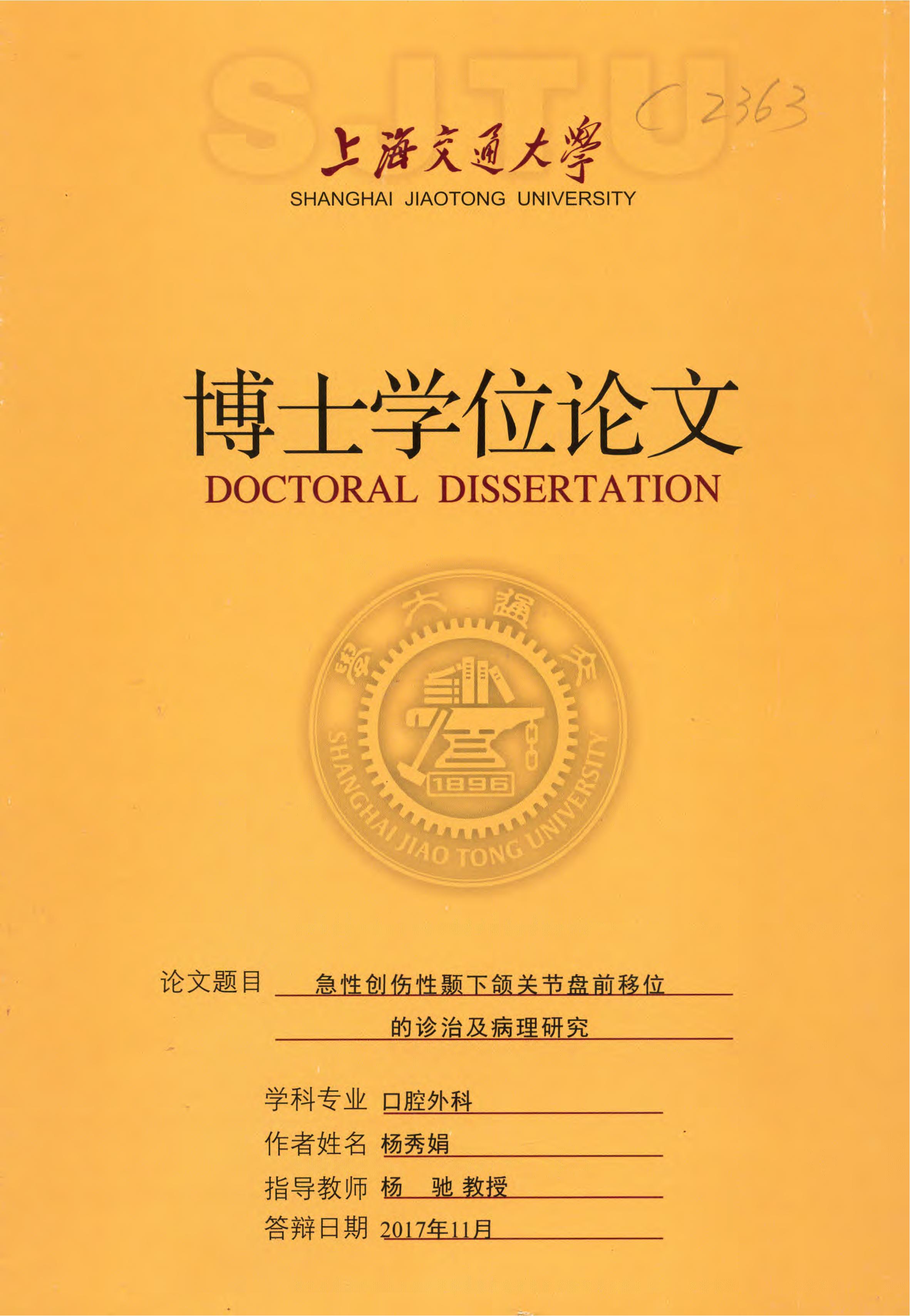
[目的] 通过对急性创伤性颞下颌关节盘前移位(Acute traumatic disc displacement, ATDD)诊断、自然转归、关节盘复位手术疗效及病理机制的回顾性研究,制定该疾病的诊断标准,并探讨其最佳治疗方法。 [方法] 1.研究对象为2010年3月-2015年3月在我科诊断为ATDD的40例55侧关节。病例纳入标准:下颌骨外伤史;既往无关节症状;CT显示患侧无髁突骨折;MRI显示关节盘前移位,长度和形态基本正常。 2.按发病时间分为急性期(≤2w)、亚急性期(>2w,≤2m)及慢性期(>2m),通过MRI检查评价三个时期患者髁突的骨质破坏情况。 3.所有患者按治疗方法不同分为保守治疗组、关节盘复位手术组和关节置换组,通过对保守治疗和关节盘复位手术2组患者张口度及MRI的随访,分别评价患者下颌功能恢复和髁突骨质改建情况,从而对关节复位手术的疗效进行比较。通过对保守无效行关节置换手术前后张口度比较,评价关节置换手术疗效。 4.将慢性期发生严重骨关节炎或关节纤维强直进行关节置换的髁突与非急性创伤的骨关节病髁突进行病理比较,初步探讨创伤性骨关节炎(PosttraumatiC OsteoarthritiS,PTOA)的病理机制。 5.采用SPSS20.0软件包对数据进行统计学处理。 [结果] 1.急性和亚急性期共5/26侧(22%)髁突MRI显示骨质破坏,慢性期22/29侧(76%)髁突MRI显示骨质破坏,慢性期的髁突骨质破坏发生率显著高于急性期-亚急性期。 2.32例43侧关节随访时间为2-64个月,平均16.5个月。关节盘复位手术组21侧关节,术后MRI随访显示其中1侧(5%)有新骨生长,13侧(62%)骨质无破坏,6侧(28%)骨质轻度破坏(其中5侧较术前无明显变化),1侧(5%)重度吸收;保守治疗组25侧关节,MRI随访显示1侧(4%)无破坏,11侧(44%)轻度破坏,13侧(52%)重度吸收,保守治疗组骨折破坏比例显著高于手术组。保守治疗组平均张口度为24㎜,手术组术前平均张口度25.6㎜,术后张口度35.6㎜,保守治疗组与手术治疗组术后、手术治疗组术前与术后比较均有显著差异。关节置换组8例13侧关节,手术前平均张口度为16.1㎜,术后平均张口度31.8㎜,有显著改善。 3.创伤性骨关节炎的主要病理特征是软骨和软骨下骨的吸收和血管增生等炎症反应,软骨表面伴有不同程度的纤维增生,与非急性损伤性骨关节炎的病理表现相似,但急性创伤导致的骨吸收及血管增生更为活跃。 [结论] 1.急性创伤性颞下颌关节盘前移位易发生骨破坏并随时间的推移而加重,严重者可形成骨关节炎或关节纤维强直。 2.对于急性和亚急性期创伤性颞下颌关节盘前移位,手术复位关节盘,可预防髁突骨质破坏,防止骨关节炎及关节强直的发生;对于慢性期骨质严重破坏的患者,关节置换可改善患者张口和下颌运动功能。 3.创伤性骨关节炎病理以软骨吸收和炎症反应为主,有时伴纤维增生,与普通骨关节炎类似,但骨吸收及炎症反应更为活跃。 关键词 颞下颌关节,急性创伤性关节盘前移位,急性创伤性骨关节炎,关节强直
[Objectives] To evaluate the diagnosis, progression, sequelae and pathological mechanism of acute traumatic temporomandibular joint disc displacement (ATDD) , as well as to introduce the effective treatment for this disease. [Methods] 40patients with 55 joints of ATDD treated from 2010 to 2015 in our department were reviewed. The patients with recent history of mandibular trauma and MRI confirmed disc displacement were included. The patients who had previous history of TMJ symptoms and CT confirmed condylar fracture in the affected side were excluded. All patients were divided into 3 stages: acute stage (≤2 w), subacute stage (>2w,≤2m)and chronic stage (>2 m). According to different treatments, the patients with results of followed-up were divided into conservative group (25 joints), surgical group with disc reduction operation(33 joints) and joint replacement group (13 joints). The average maximal mouth opening (MIO) and MRI imaging were followed up to evaluated the mandibular function and condyler bone resorption. The treatment effects of 3 groups were statistical analysised by SPSS 20. The pathlogical manifestations of the condylar which were resected due to osteoarthritis with or without acute trauma were compared. [Results] 43 joints of 32 patients were followed up for 2-64 months, with the average of 16.5 months. Among the acute and sub-acute stage, 5 out of 26(19%) joints displayed bone resorption, while 22 out of 29(76%) joints among the chronic stage displayed bone resorption. In the surgical group (21 joints) , the follow up results of MRI showed 1 joint (5%) of new bone growth, 13 joints (62%) of no resorption, 6 joints (28%)of slight bone resorption (5 joints had no change compared with pre-operation) and 1 joint (5%) of serious bone resorption. In the conservative group (25 joints), the follow up results of MRI showed 1 joint (4%) of no resorption, 11 joints (44%) of slight bone resorption and 13 joints (52%) of serious bone resorption. The proportional of bone resorption in conservative group was significantly higher than in surgical group. The average MIO of conservative group was 24㎜. The average MIO of surgical group before and after operation were 25.6㎜ and 35.6㎜, respectively. The post-operation MIO was significantly improved compared with both pre-operation and conservative group. The average MIO of joint replacement group after operation were 31.8㎜, which was significantly improved compared with the average MIO before operation (16.1㎜). The pathological study of posttraumatic osteoarthritis (PTOA) and chronic ostearthritis(OA) showed similar pathological characteristics of cartilage and bone resorption as well as inflammatory response of vascular proliferation, while the inflammation and resorption were more active in PTOA. [Conclusions] In conclusion, ATDD may cause bone resorption which will progressed to severe osteoarthritis or ankylosis. Surgically disc reposition as early as possible in the acute and sub-acute phases can effectively protect the condylar and significantly reduce the occurrence rate of above sequelae. PTOA also has the pathological characteristics of bone resorption and inflammation reaction which are similar with chronic OA, but the resorption of bone and inflammation reaction in PTOA are more active. Key words: Temporomandibular joint, Acute traumatic disc displacement(ATDD), Posttraumatic Osteoarthritis(PTOA), Fibrous ankylosis